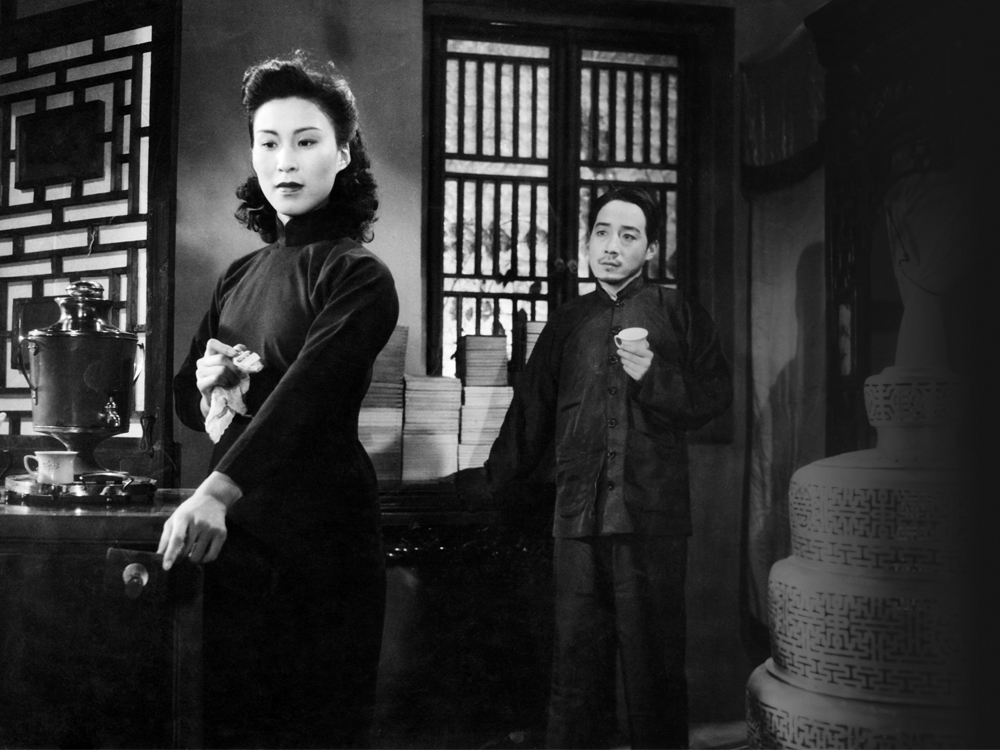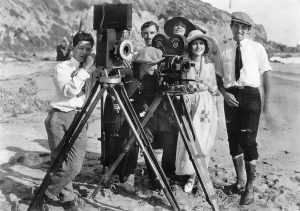Every day while CFI’s Hollywood readers take in the business of the Chinese film industry, the actual movies can sometimes seem exotic or remote. But in major US cities, mainstream Chinese films are increasingly available: thanks to Wanda’s purchase of AMC and distributors like China Lion, they get American theatrical releases practically simultaneous to their premieres at home. Though they receive virtually no publicity outside the non-Chinese community, these films are more than worth seeking out by anyone serious about engaging the Chinese industry, understanding the Chinese sensibility and familiarizing themselves with China’s talent pool. Periodically, CFI will review and point readers in the direction of noteworthy US releases of contemporary commercial and independent Chinese titles.
One of our most incisive and illuminating critics, Bérénice Reynaud is a pioneering explorer of Chinese film, someone who since the 1980s has led readers in the West to new discoveries and understanding about Chinese directors, their work and the system in which it is produced. Last month, the Cinémathèque Française in Paris presented New Voices in Chinese Cinema, a series she curated to spotlight significant work by directors of the Sixth Generation and beyond– generally speaking, when she suggests you check out something, it is more than worth your time.
In the spring of 2006, for Le Monde, Ms. Reynaud assembled a quick and necessary list called The Greatest Chinese Films, 21 selections from the golden era of Shanghai studio production through the present day. Translated by Krystyna Horko, it was republished in the paper’s English-language version of its monthly review, Le Monde Diplomatique. With their kind permission, we are pleased to reprint it here.

Spring in a Small Town (1948, dir. Fei Mu)
The Greatest Chinese Films
Red Heroine (1929, Shanghai, silent, dir. Wen Yimin)
One of the oldest martial arts films, with rudimentary special effects. Chinese and English title boards show Shanghai cinema was already international. A peasant girl is kidnapped and threatened with rape by troops commanded by a local warlord. She is saved by a Taoist hermit who teaches martial arts.
The Goddess (1934, Shanghai, dir. Wu Yonggang)
Ruan Lingyu, star of the golden age of Shanghai cinema, plays a single mother who becomes a prostitute to send her child to school. This is more than just a melodrama; it is a movie classic. Ruan Lingyu committed suicide a year later at the age of 25.
Street Angel (1937, Shanghai, dir. Yuan Muzhi)
Zhou Xuan was famous at 18 for her golden voice and her performance as a refugee from Manchuria who sings on the streets in Shanghai. She falls in love with a poor trumpet player (great actor Zhao Dan) but is threatened by mobsters. An excellent example of intellectual and artistic talent in Shanghai.
Mulan Joins the Army (1939, Shanghai, dir. Bu Wancang)
The director chose Nancy Chan from Hong Kong for this third version of the myth that dates back to the sixth century. A woman trained in martial arts disguises herself as a man to replace her sick father in the imperial army. An officer falls for him/her. Bu Wancang was criticised for having made a film during the Japanese occupation.
The Spring River Flows East (1947, Shanghai, dir. Cai Chusheng and Zheng Junli)
This revived the war years with a combination of archive footage, epic scenes and melodrama, and was a great success. A teacher is separated from his wife and child, who flee to the countryside to stay with his parents. There, the wife finds the peasants suffering under Japanese occupation.
Spring in a Small Town (1948, Shanghai, dir. Fei Mu)
Perhaps the most beautiful pre-1949 film and swan-song of the great director Fei Mu. A woman lives in a ruined house with her sick husband, sister-in-law and old servant. When her former fiancé visits she is torn between Confucian morals and a passion that never died. The film, often considered a metaphor for the impotence of Chinese intellectuals, inspired a recent remake by Tian Zhuangzuang.
Crows and Sparrows (1949, Shanghai, dir. Zheng Junli)
Chinese-Italian realism: secretly shot in the Shanghai slums during the weeks preceding the communist victory, and about the lives of ordinary people: a group of tenants fighting their landlord, a Kuomintang officer who wants to evict them.
The White-Haired Girl (1950, Xingshan, dir. Wang Bing and Sui Hua)
Filmed by the Northeastern Studio, this began a new era for the Chinese cinema, combining a revolutionary storyline with decentralized production. The story of a peasant woman sold to a landlord to pay her father’s debts, who escapes to wander the mountains for years until found by a Red Army detachment.
February (1963, Beijing, dir. Xie Tieli)
In the 1920s a teacher working in the country falls in love with the headmaster’s sister, but people start gossiping. The film was adapted from a short story by Rou Shi, a communist writer shot by the Kuomintang in 1931 aged 29. Although popular with the public, it was criticized for a “feudal mentality”.
Stage Sisters (1965, Shanghai, dir. Xie Jin)
Xie Jin, a major post-1949 filmmaker, tells the story of two singers in an opera troupe. One specializes in male roles; she is an idealist and has embraced the revolution. The other becomes a gangster’s moll and quits the stage. They meet again after the revolution. One of the last films made before the Cultural Revolution, and criticized and banned for 15 years.
The Red Detachment of Women (1971, Beijing, dir. Pan Wenzhan and Fu Jie)
During the Cultural Revolution, 1967-1975, China produced only a few model works (yangbanxi), encouraged by Jiang Qing, Mao’s wife. The most famous was the ballet, The Red Detachment of Women, based on a story first filmed by Xie Jin in 1961, about communist women soldiers in the 1930s on Hainan island.
River Without Buoys (1983, Xi’an, dir. Wu Tianming)
The story of three men floating a timber raft down the river during the Cultural Revolution. The oldest meets his first love, now a beggar. The youngest looks for his fiancé, forcibly married to someone else. The third, a married man, is in self-denial. Wu Tianming was appointed director of the Xi’an studios in 1983 and was an instigator of the post-1978 political thaw. He later produced films and went into exiled in the US after he criticized the Tiananmen Square suppression.
Yellow Earth (1984, Guangxi, dir. Chen Kaige)
This launched the fifth generation and brought Chinese cinema into the international spotlight. In 1939, a soldier in the Eighth Army arrives on the deserted Shaanxi plateau to collect folksongs. He befriends a peasant woman about to be forced into an arranged marriage, but is powerless to help her. The film has visual intensity, original direction, a disillusioned viewpoint and a gloomy treatment of official history.
Women’s Story (1987, Shanghai, dir. Peng Xiaolian)
This follows the lives of three countrywomen in the city to find a friend who has gone to have her second child in secret since it was against the official one-child policy. Because it was viewed in the West as a criticism of that policy, the film was banned in China. After 1989 Peng Xiaolian spent several years in New York before returning to China.
Woman-Demon-Human (1987, Shanghai, dir. Huang Shuqin)
China has long had a large number of women film directors, and there were many successful women’s films in the 1980s, including Sacrificed Youth (1985), Good Morning Beijing (1990), Army Nurse (1985), and this, the story of a female opera singer’s efforts to get male roles. The trend continued with Blush (1994), a story of two prostitutes liberated after 1949, and Perpetual Motion (2005), a disturbing portrait of modern women.
The Blue Kite (1993, Beijing, dir. Tian Zhuangzhuang)
The child hero’s father was a victim of the 1957 anti-rightist movement. His mother learns to forgive, then to love the man who denounced the father to the authorities, but he dies of starvation during the Great Leap Forward. She marries a cadre who is attacked by the Red Guards. The director and his scriptwriter, Xiao Lao, did many interviews to get personal stories of repression in the 1950s and 1960s. The film was banned.
Cop Patrol in Beijing (aka On the Beat) (1993, Beijing, dir. Ning Ying)
Riding bikes, armed only with batons, the cops do their rounds, listen to street-committee gossip, arrest drunkards and sellers of pornography, confiscate unlicensed dogs and track down rabid ones. In the evenings they watch US soaps or quarrel with their wives. One day everything goes haywire because of a suspect and a slap. Ning Ying worked with real policemen and pays them homage while exploring the complexity of her native city.
Sons (1996, Beijing, dir. Zhang Yuan)
In early sixth-generation neorealist mode, Zhang Yuan asked the neighbors in his block, a pair of former lead dancers and their sons to play themselves to capture a family in crisis in the post- socialist void. The father is an alcoholic; the mother gives dancing lessons and the sons hang out in the underground rock scene, get drunk and hit their girlfriends.
Pickpocket (1998, Fenyang, dir. Jia Zhangke)
Jia returns to his hometown in Shanxi province to observe the post-socialist changes through his antihero, a pickpocket, who believes in honor among thieves. But his former associates have become arrogant businessmen, his peasant family rejects him, and his love affair with a hostess is going nowhere.
Hero (2002, Hong Kong/Beijing, dir. Zhang Yimou)
Zhang Yimou arranged Gong Li’s debut with Red Sorghum (1987) and directed her best film, The Story of Qiu Ju (1992). In this he brings together two actors from the mainland, Jet Li and Zhang Ziyi, and two from Hong Kong, Maggie Cheung and Tony Leung, to capitalize on the renaissance of the martial arts film. Spectacular scenery, special effects, music by Tan Dun, Chris Doyle behind the camera, fighting choreographed by the Hong Kong master Ching Siu-tung.
West of the Tracks (2002, Shenyang, dir. Wang Bing)
The cinematographic event of the year: a nine-hour documentary about the slow death of an industrial area in northeastern China. Only the trains still work. It took Wang Bing three years to marshal this material on China’s transition to the post-industrial era.
— Le Monde Diplomatique, English Edition, April 2006
WHAT DOES THE GRADE MEAN?
Here are some recent & modern-era vintage Chinese and Hong Kong films for comparison
- A+
- PLATFORM (2000, dir Jia Zhangke)
- THE WORLD (2004, dir. Jia Zhangke)
- DRUNKEN MASTER 2 (1994, dir. Lau Kar Leung & Jackie Chan)
- KUNG FU HUSTLE (2004, dir. Stephen Chow)
- A
- LET THE BULLETS FLY (2010, dir Jiang Wen)
- THE MERMAID (2016, dir. Stephen Chow)
- A TOUCH OF SIN (2013, dir. Jia Zhangke)
- STILL LIFE (2006, dir. Jia Zhangke)
- MOUNTAINS MAY DEPART (2015, dir. Jia Zhangke)
- LITTLE BIG SOLDIER (2010, dir. Ding Sheng)
- EXTRAORDINARY MISSION (2017, dir. Alan Mak & Anthony Pun)
- MR SIX (2015, dir. Guan Hu)
- A WORLD WITHOUT THIEVES (2004, dir. Feng Xiaogang)
- SUZHOU RIVER (1999, dir. Lou Ye)
- HOUSE OF FLYING DAGGERS (2004, dir Zhang Yimou)
- RAISE THE RED LANTERN (1991, dir. Zhang Yimou)
- A-
- DUCKWEED (2017, dir. Han Han)
- I BELONGED TO YOU (2016, dir. Zhang Yibai)
- B+
- THE GREAT WALL (2016, dir. Zhang Yimou)
- OLD STONE (2016, dir. Johnny Ma)
- CRAZY STONE (2006, dir. Ning Hao)
- GO, LALA GO (2010, dir. Xu Jinglei)
- B
- KUNG FU YOGA (2017, dir. Stanley Tong)
- RAILROAD TIGERS (2016, dir. Ding Sheng)
- THE WASTED TIMES (2016, dir. Cheng Er)
- CHONGQING HOT POT (2016, dir. Yang Qing)
- MONSTER HUNT (2015, dir. Raman Hui)
- B-
- JOURNEY TO THE WEST: THE DEMONS STRIKE BACK (2017, dir. Tsui Hark)
- SOME LIKE IT HOT (2017, dir. Song Xiaofei & Dong Xu)
- BORN IN CHINA (2016, dir. Lu Chuan)
- D-
- TINY TIMES (2013, dir. Guo Jingming)


